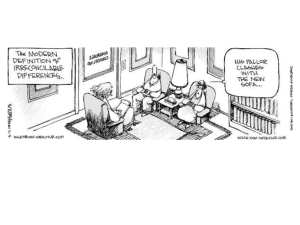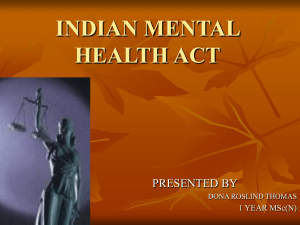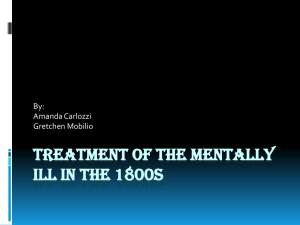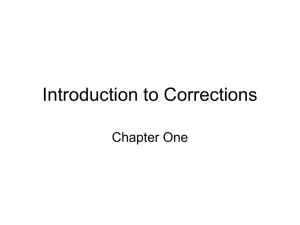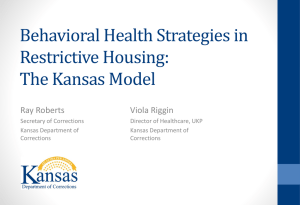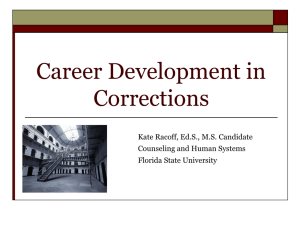Document 10467073
advertisement
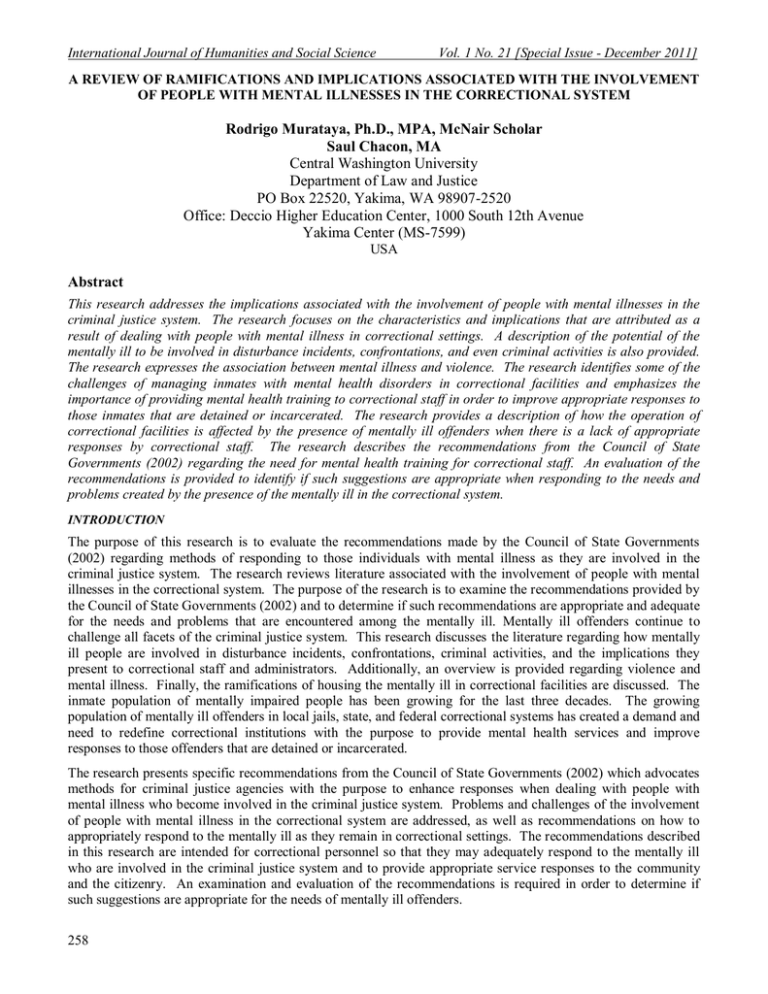
International Journal of Humanities and Social Science Vol. 1 No. 21 [Special Issue - December 2011] A REVIEW OF RAMIFICATIONS AND IMPLICATIONS ASSOCIATED WITH THE INVOLVEMENT OF PEOPLE WITH MENTAL ILLNESSES IN THE CORRECTIONAL SYSTEM Rodrigo Murataya, Ph.D., MPA, McNair Scholar Saul Chacon, MA Central Washington University Department of Law and Justice PO Box 22520, Yakima, WA 98907-2520 Office: Deccio Higher Education Center, 1000 South 12th Avenue Yakima Center (MS-7599) USA Abstract This research addresses the implications associated with the involvement of people with mental illnesses in the criminal justice system. The research focuses on the characteristics and implications that are attributed as a result of dealing with people with mental illness in correctional settings. A description of the potential of the mentally ill to be involved in disturbance incidents, confrontations, and even criminal activities is also provided. The research expresses the association between mental illness and violence. The research identifies some of the challenges of managing inmates with mental health disorders in correctional facilities and emphasizes the importance of providing mental health training to correctional staff in order to improve appropriate responses to those inmates that are detained or incarcerated. The research provides a description of how the operation of correctional facilities is affected by the presence of mentally ill offenders when there is a lack of appropriate responses by correctional staff. The research describes the recommendations from the Council of State Governments (2002) regarding the need for mental health training for correctional staff. An evaluation of the recommendations is provided to identify if such suggestions are appropriate when responding to the needs and problems created by the presence of the mentally ill in the correctional system. INTRODUCTION The purpose of this research is to evaluate the recommendations made by the Council of State Governments (2002) regarding methods of responding to those individuals with mental illness as they are involved in the criminal justice system. The research reviews literature associated with the involvement of people with mental illnesses in the correctional system. The purpose of the research is to examine the recommendations provided by the Council of State Governments (2002) and to determine if such recommendations are appropriate and adequate for the needs and problems that are encountered among the mentally ill. Mentally ill offenders continue to challenge all facets of the criminal justice system. This research discusses the literature regarding how mentally ill people are involved in disturbance incidents, confrontations, criminal activities, and the implications they present to correctional staff and administrators. Additionally, an overview is provided regarding violence and mental illness. Finally, the ramifications of housing the mentally ill in correctional facilities are discussed. The inmate population of mentally impaired people has been growing for the last three decades. The growing population of mentally ill offenders in local jails, state, and federal correctional systems has created a demand and need to redefine correctional institutions with the purpose to provide mental health services and improve responses to those offenders that are detained or incarcerated. The research presents specific recommendations from the Council of State Governments (2002) which advocates methods for criminal justice agencies with the purpose to enhance responses when dealing with people with mental illness who become involved in the criminal justice system. Problems and challenges of the involvement of people with mental illness in the correctional system are addressed, as well as recommendations on how to appropriately respond to the mentally ill as they remain in correctional settings. The recommendations described in this research are intended for correctional personnel so that they may adequately respond to the mentally ill who are involved in the criminal justice system and to provide appropriate service responses to the community and the citizenry. An examination and evaluation of the recommendations is required in order to determine if such suggestions are appropriate for the needs of mentally ill offenders. 258 The Special Issue on Commerce and Social Science © Centre for Promoting Ideas, USA LITERATURE REVIEW This research provides an overview of the involvement of people with mental illnesses in the correctional system. The research describes (a) violence among people with mental illness; and (b) mentally ill offenders in correctional institutions. Violence among people with Mental illness Mental illnesses contribute very little to the overall rate of violence in the general population, but an increased risk of violence is possible when substance abuse is present among the mentally ill (Friedman, 2006, p. 2064). Substance abuse is a factor that plays a role among the people with mental illnesses who commit violent crimes (Constable, 2008, p. 13). Mental illness is a major risk factor for victimization; people with mental illnesses are violently victimized at rates of two to three times higher than the general population (Glassberg & Dodd, 2008, p. 4). Constable (2008) found that more than one-fourth of people with severe mental illness were the victims of violent crime each year and that people with mental illness were 23 times more likely to be raped, 15 times more likely to be assaulted, and were the victims of theft 140 times more often than those in the general population (p. 13). Most people have the notion to think that the mentally ill are dangerous; however, people with mental illnesses are more likely to be hurt than to hurt other people because they are more vulnerable to crime (Constable, 2008, p. 13). Teasdale (2009) noted that individuals with mental disorders are more likely to become victims of violent crimes than to commit such acts, and that people who are mentally ill become particularly vulnerable for victimization during times of homelessness and when suffering from alcohol abuse (p. 513). Psychological symptom severity among people with mental illnesses predicts increases in non-violent criminal activity such as public disturbance activities (Fischer, Shinn, Shrout, & Tsemberis, 2008). Fischer et al. (2008) defined public disturbances as activities such as drinking, urinating in public, and indecent exposure as actions that were expressed in very noticeable ways such as talking loudly and experiencing hallucinations in public (p. 262). The Sentencing Project of (2002) presented three different categories of crime committed by people with mental illnesses. These categories included the following: (a) illegal acts- such as disorderly conduct, criminal trespass, indecent exposure, disturbing the peace and public intoxication; (b) economic crimes to obtain money for subsistence such as petty theft, shoplifting, and even prostitution; and (c) more serious offenses such as burglaries, assaults and robberies (p. 7). Additionally, Fischer et al. (2008) suggested that when substance abuse was controlled among people with mental illnesses, violent behavior between men and women with psychiatric problems have non-significant differences or smaller differences than those individuals in the general population who do not have mental health disorders (p. 262). However; Sadoff (2004) mentioned that the presence of drug and alcohol problems along with mental disorders elevates the potential for criminal behavior (p. 185). The factors associated with violent behavior among people with mental illnesses include drug and alcohol abuse, noncompliance with medication requirements, and biological and biochemical disorders (Cordner, 2006, p. 4). Furthermore; Cordner (2006) emphasized that violent and criminal acts directly attributable to mental illness account for a small proportion of acts in the United States and that most mentally ill offenders are not violent (p. 4). The higher rate of criminality and violence among the mentally ill might be attributed to the fact that arrests and convictions are facilitated for individuals with such disorders (Sadoff, 2004, p. 185). Sadoff (2004) explained that persons suffering from major mental disorders are not more likely to commit crimes than individuals without mental disorders, but that people with mental disorders are more likely to be detected by the police and successfully prosecuted (p. 185). The Sentencing Project of (2002) emphasized the following regarding the behavior of people with mental illnesses: People with mental illness are more likely to exhibit the kinds of behaviors that will bring them into conflict with the criminal justice system, particularly under current policies of “zero tolerance” and arrests for “quality of life” crimes. According to the Bureau of Justice Statistics, prisoners with mental illnesses were twice as likely as other inmates to have been homeless prior to their arrest; forty percent were unemployed; and nearly half said they were binge drinkers. Many people who suffer from both mental illness and substance abuse (referred to as co-occurring disorders) are particularly at risk of incarceration. Estimates of the proportion of people with mental health disorders who also have a substance abuse disorder range between 25-50 percent. Almost 60 percent of mentally ill state prisoners reported using drugs in the month before their arrest (p. 7). 259 International Journal of Humanities and Social Science Vol. 1 No. 21 [Special Issue - December 2011] The Sentencing Project of (2002) concluded that untreated mental illnesses and substance abuse disorders lead to repeated crimes among individuals with mental illnesses causing a revolving door between a correctional institution or jail and the street (p. 7). Substance abuse and mental illnesses are important risks factors for imprisonment and homelessness and homeless people who have mental health and substance abuse disorders have low rates of obtaining treatment for their disorders (Kushel, Hahn, Evans, Bangsberg, & Moss, 2005, p. 7). Furthermore; Kushel et al. (2005) described the association between homelessness and imprisonment and concluded that imprisonment may precipitate homelessness by disrupting family, community contacts and by decreasing employment and housing prospects; thus, increasing the risk of recidivism among those individuals that were incarcerated (p. 1747). Cordner (2006) added that people with mental illnesses are closely connected to other problems such as homelessness, drug, and alcohol abuse (p. 6). Offenders with mental illnesses report extremely high rates of recidivism and mentally ill offenders cycle through the criminal justice system as they constantly move in and out of jail and the community (Rivera, 2004, p. 107). Rivera (2004) reported that 90 percent of the mentally ill inmates in Los Angeles County Jail were repeat offenders and that nearly 10 percent of those mentally ill offenders had been incarcerated on ten or more instances (p. 107). Additionally, Rivera (2004) provided another study of recidivism among mentally ill offenders from the Lucas County Jail in Ohio. The study revealed that 70 percent of the mentally ill offenders who were released from Lucas County Jail were re-arrested within a three-year period (p. 107). A common misperception of some individuals is that people with mental illness are violent and dangerous; by obtaining a comprehensive understanding of how of mental illness relate to criminal activity and violence, criminal justice personnel can develop and improve their strategies on how to respond when dealing with such offenders. In developing such strategies, it is important to recognize the factors that contribute to recidivism among mentally ill offenders, the type of crimes they commit, and the factors that are associated with violent behavior as well as the causes that contribute to the presence of the mentally ill in the criminal justice system. Mentally ill Offenders in Correctional Settings Several significant factors, specifically crime control strategies have contributed to the overwhelming number of offenders that currently exist in correctional facilities and detention centers throughout the United States. Weiss and South (1998) found that some of those factors include truth in sentencing guidelines, mandatory minimum sentences, tough approach to crime control and drugs, and the implementation of three strikes (p. 51). The Sentencing Project of January, (2002) described some of the driving forces and factors that have contributed to the high proportion of mentally ill within the criminal justice system. The Sentencing Project of January, (2002) identified such driving forces as untreated mental illness in the community which included reduction in treatment spending and availability, barriers to involuntary commitment, attitudes towards mental illness and violence, punitive approaches adopted by the courts, legislatures, and police to the treatment of people who do not fit within societal norms, and the lack of pre-release planning and system integration. There are three times more mentally ill persons in US prisons than in mental health hospitals and the rate of mental illness in our nation’s prison population is three times higher than in the general population (Jackson, 2004, p. 6). Easley (2009) noted that 15 to 24 percent of US prison inmates have a severe mental illness and that half of them have at least one mental health problem (p. 3). The mentally ill may be at special risk of mistreatment by fellow prisoners and as a result may become volatile and aggressive (Easley, 2009, p. 3). Taxman, Young, and Byrne (2002) provided that nearly 10 percent of offenders in US state prisons were using psychotropic medications while incarcerated for their mental health issues and that 13 percent of the state inmates received some type of mental health therapy such as counseling (p. 22). The prevalence of mental health disorders among the prison population carries over to the community where medication and access to services are limited due to the lack of health insurance, thus problems associated with providing treatment to people with mental illness are present in both institutions and community based service programs (Taxman et al. 2002, p. 23). The number of inmates with mental health disorders in correctional facilities throughout the country is increasing at an expeditious rate (Geiman, 2007, p. 22). There are 2.2 million people in American jails and prisons and of these, an estimated 330,000 are mentally ill (Pfeiffer, 2007, p. 8). During the year 2005, more than half of prison and jail inmates had a mental health problem including 56 percent of state prisoners, 45 percent of federal prisoners, and 64 percent of jail inmates (James & Glaze, 2006, p. 1). As many as 700,000 adults entering jails each year have active symptoms of serious mental illnesses and psychotic disorders (McPherson, 2008, p. 62). 260 The Special Issue on Commerce and Social Science © Centre for Promoting Ideas, USA Sixteen percent of the nearly 2 million prison inmates in the United States were diagnosed with some form of mental illness (White & Gallespie, 2005, p. 108). Throughout the nation’s prison systems the number of mentally impaired offenders has being growing for nearly 30 years; thus, local jails and state and federal correctional systems have seen a huge influx of mentally ill offenders (Stahl & West, 2001, p. 72). As the number of mentally ill offenders increase in jails and prisons, the demand for new mental health programs and projects addressing mental health care issues is necessary in correctional institutions (Stahl & West, 2001, p. 72). Gannon (2005) mentioned that with the doubling and tripling of correctional populations, the call for knowledgeable mental health professionals and staff can lead to creating a safer work living environment in the corrections setting (p. 8). In spite the fact that most prisons and jails are not and have never been structured to deal with high maintenance mentally ill offenders; correctional systems across the nation are being asked to fulfill what amounts to an enormous unfunded mandate because correctional institutions are required to provide mental health programming and services in addition to maintaining security and custody (White & Gillespie, 2005, p. 108). In many situations, correctional institutions face unintended consequences such as depriving the mentally ill from adequate treatment; thus, mentally ill offenders who are in correctional settings do not have sufficient opportunities to remain in open population or receive treatment other than periodic reviews and psychiatric medication (White & Gillespie, 2005, p. 108). They emphasized that the psychological conditions of mentally ill offenders who are in correctional settings can quickly deteriorate and lead to increased risks of suicide, violence or psychotic episodes (p. 108). In describing mentally ill offenders in correctional institutions, Easley (2009) concluded the following: The nation’s prisons now constitute the largest mental institutions in the country. They are unsuitable to sites for care and treatment. The mentally ill are at unique disadvantage in prisons, where the basic purpose of such institutions is punishment, not therapy, and the guards may be poorly trained or motivated to deal with prisoners who might have problems conforming to rules and procedures. The mentally ill may be at special risk of mistreatment by fellow prisoners and conversely may be volatile, disruptive, and aggressive. Their inability to obey rules puts them at risk of solitary confinement, and such experiences might very well exacerbate their problems. The result in some cases is suicide attempts and sometimes they are successful in committing suicides (p. 3). Geiman (2007) described the existence of predictable consequences when the practice of placing mentally ill offenders in correctional facilities occurs. She added that on a daily basis, correctional officers might experience bizarre behaviors from mentally ill offenders such as strange illusory perceptions, confusion, the inability to follow rules and possible assaults (p. 22). When describing mentally ill offenders in correctional institutions, Geiman (2007) noted an assertion made by research psychiatrist Fuller Torrey that included: Being in jail or prison when your brain in working normally is, at best, an unpleasant experience. Being in jail or prison when your brain is playing is often brutal. These institutions that have rigid rules both explicit and implicit and a major purpose of incarceration is to teach inmates how to follow such rules. Because of illogical thinking, delusions and auditory hallucinations, many of the mentally ill cannot comprehend the rules of jails and prisons and this has predictable and sometimes tragic consequences (p. 22). Geiman (2007) defined predictable consequences as those situations that correctional staff and correctional officers on the front line face on a daily basis. For example, she asserted that mental illness can impair a person’s to think, feel and behave normally and as a result offenders with mental disabilities may act in unexpected and abnormal behaviors such as talking incoherently, having hallucinations, and life-threatening behaviors such as attempting suicide (p. 22). People with mental illnesses who are incarcerated think in chaotic patterns as they imagine things and yell out to silent voices, thus making it difficult to obey and follow the rules of jails and prisons (Pfeiffer, 2007, p. 17). Geiman (2007) noted that in many instances the overcrowding, constant noises, strict rules and lack of privacy can worsen the symptoms on the mentally dysfunctional offenders (p. 22). Corrections officers are required to resolve situations involving inmates with mental illnesses and substance abuse problems, but because of the limited resources available to criminal justice staff some correctional agencies have not been successful in providing appropriate and adequate responses for such offenders (Bynum & Phillips, 2008, p. 66). Geiman (2007) found that the Criminal Justice and Mental Health Consensus Project Report of 2002 defined appropriate and adequate responses when dealing with mentally ill offenders as follows: 261 International Journal of Humanities and Social Science Vol. 1 No. 21 [Special Issue - December 2011] The report recommends that staff receive training on topics such as understanding mental illness and its relationship to violence; understanding the special needs of inmates with special mental health disorders; identifying the signs and symptoms of mental illness; identifying offenders with mental health issues; making appropriate referrals to mental health staff; improving communication between staff and inmates with mental health disorders; responding to crisis situations and preventing suicides (p. 22). Bynum and Phillips (2008) suggested that the National Association of Mental Illness recommends corrections officers to receive in service education on mental health issues such as identifying signs of mental health issues, providing referrals to mental health staff, suicide prevention, and crisis intervention measures (p. 66). The need for mental health education training for corrections staff is imperative because in addition to the existing problems of overcrowding, understaffed, and under funded programs in correctional facilities; correctional officers are not adequately educated or trained to handle situations involving mentally ill inmates (Bynum & Phillips, 2008, p. 66). In describing training for corrections officers, Bynum and Phillips (2008) recommended that a single curriculum be developed for all corrections officers in order to have a basic knowledge of mental health, drug and alcohol issues with the purpose of providing the adequate responses to the mentally ill offenders (p. 66). Most prisons and jails miss the majority of inmates with mental health problems at intake or during the booking process because of lack of training by staff and lack of screening procedures implemented by the institutions (Goldberg & Higgings, 2006, p. 82). To identify detainees who are mentally ill, correctional administrators must provide training for correctional staff and implement brief and cost effective mental health screenings (Goldberg & Higgings, 2006, p. 82). Some of the mental health training recommendations for corrections personnel provided by the Council of State Governments (2002) included: (a) provide basic training regarding mental health issues to all corrections staff who come into contact with detainees or inmates with mental illness; (b) incorporate competency-based training in mental health issues in existing academy pre-service training programs and inservice programs for corrections staff; (c) Provide advanced training to corrections staff assigned to work specifically with inmates with mental illness; (d) provide parole board members with training in order to inform them about issues regarding the release of people with mental illness from prison; and (e) provide training for parole officers to improve their ability to supervise parolees with mental illness. Basic training needs identified and recommended by the Council of State Governments (2002) included training goals aimed at: (a) improve staff’s ability to identify inmates with possible mental health issues; (b) enable staff to understand when to refer an inmate for a mental health screening or assessment; (c) teach staff to recognize symptoms of an adverse reaction to psychotropic medication; (d) reduce stigmatization of inmates with mental illness by sensitizing corrections staff to the unique needs of these individuals; (e) provide information on issues related to substance abuse among the mentally ill; and (f) improve the ability of corrections officers to communicate facility rules and procedures to inmates with mental illness (p. 227). The report added that any corrections personnel who have regular interaction with inmates with mental illness should receive this basic training in order to better serve that particular group of offenders and that personnel should include uniformed security staff, case managers, teachers, and vocational counselors (p. 226). The Council of State Governments (2002) recommends mental health training in pre-service (such as academy) and in in-service programs for corrections staff that include basic issues concerning mental illness and the management of inmates with mental illness. Pre-service training issues of included: (a) attitudes about mental illness; (b) relationship between violence and mental illness; (c) signs and symptoms of mental illness; (d) substance abuse and mental illness; (e) homelessness and mental illness; and (f) understanding and assessing mental illnesses (p. 228). The report also provided that the management of inmates with mental illness included de-escalation techniques, officer safety, calming approaches, suicide prevention, referral procedures, and the identification of medication side effects (p. 228). Furthermore, the report emphasized that corrections staff assigned to work specifically on units with inmates at high risk of mental illness should receive intensive and specialized training beyond the required basic mental health curricula, especially in dealing with de-escalation techniques, restraints, and the continuum of force (p. 229). The Council of State Governments (2002) recommended providing parole board members with training regarding the release of people with mental illness from prison. The report suggested that training can enhance parole board member’s understanding of the complex issues presented by this offender group and enabled them to make informed decisions regarding parole candidates (p. 230). 262 The Special Issue on Commerce and Social Science © Centre for Promoting Ideas, USA Additionally, the report expressed that parole board members should have a fundamental understanding about the nature of mental illness, being able to identify the risks and needs associated with mental illness, types of treatment, resources and support services that may help mitigate such risks (p. 230). The Council of State Governments (2002) concluded that parole officers must receive training on the availability of community mental health resources, intervention services, alternatives to revocation, sensitivity of victims and updates on the changes of mental health treatment law (p. 231). There are many offenders with mental illnesses, who are detained, convicted, and incarcerated in prisons or jails. Correctional institutions have the responsibility to provide appropriate responses when dealing with such offenders. Some of the issues that surface by the presence of the mentally ill in correctional institutions can include, expensive cost, housing issues, increased use of force by correctional staff, inability to follow rules and regulations, suicides, suicide ideations, inability to obtain proper medication for their mental illness. In the case of a lack of or absence of training, there is also the possibility that corrections personnel will fail to properly identify offenders with mental illnesses and refer them to the appropriate mental health personnel. The Council of State Governments (2002) recommended that in addition to the basic mental health training for corrections personnel, continued in-service training, and advance training should be provided for corrections staff on mental health issues and management of inmates with mental illness. The purpose of such training is to recognize symptoms of mental illness, and respond appropriately to people with such. Those receiving training can include any corrections personnel who have regular interactions with inmates with mental illness. DISCUSSION After reviewing the literature on the involvement of the mentally ill in the correctional system and the recommendations provided by the Council of State Governments (2002) , the Report’s recommendations are in harmony with the challenges and needs of criminal justice personnel who interact with the mentally ill. The Council of State Governments (2002) actually addresses the common needs and challenges identified by researchers who have studied the implications the mentally ill create for our criminal justice system. Correctional personnel should consider such recommendations for their methods of responding to the mentally ill because when such suggestions are properly implemented, they create a sense of community-policing efforts that build a stronger and trusting relationship with the public and the communities they serve. However, criminal justice agencies must be aware of the challenges and impediments for implementing such recommendations. Some of those challenges include the lack of community resources, lack of funding, lack of collaboration from other agencies, and the lack of proper planning. Additionally, many jurisdictions and departments do not count with the appropriate funding and financial support to provide additional training for their personnel. Agencies seeking to adopt the recommendations provided by the Council of State Governments (2002) must conduct an assessment to determine their needs and know how local community resources and programs assist when responding to the mentally ill. When criminal justice agencies do not have the appropriate funding to provide training and implement recommendations, criminal justice personnel should consider seeking financial support by presenting grant proposals with the goal to obtain financial resources in order to establish the recommended training. Goals and objectives for such training should be identified as well as the resources needed to implement the recommendation. These steps are imperative for proper planning and should be considered when introducing any type of proposed change. Criminal justice agencies should also consider looking at the training strategies used by other agencies when implementing training for their personnel. CONCLUSION The literature review in this research suggests that as people with mental illness become involved in the criminal justice system, challenges emerge for correctional personnel as they process and manage these individuals. Despite of the findings that mental illness is a risk factor for victimization and that it contributes very little to the overall rate of violence, the number of people with mental illness involved in the criminal justice system continues to rise. Risk factors that contribute to such involvement include tough approach to crime incentives, homelessness, substance abuse among people with mental illness, and the lack of community resources. Research found that a traditional punitive approach to crime continues to be the preferred method when dealing with mentally ill offenders. 263 International Journal of Humanities and Social Science Vol. 1 No. 21 [Special Issue - December 2011] Finally, the literature discussed the implications of people with mental illness in correctional facilities. A variety of issues and problems presented by the presence of the mentally ill in correctional facilities were identified. Recommendations from the Council of State Governments (2002) were provided for corrections personnel on how to improve responses when dealing with the mentally ill. Some of those recommendations included training for all criminal justice personnel working in correctional facilities that are likely to encounter and interact with people with mental illness. Other recommendations included working in collaboration with community mental health professionals and programs but the lack of funds and the lack of community resources were identified as impediments to such recommendations. Agencies seeking to implement the recommendations provided by the Council of State Governments (2002) must take in consideration the challenges encountered when adopting such recommendations. Challenges such as the lack of funding, lack of community resources, and the lack of planning should be consider when incorporating such training strategies. One of the methods to address the funding issue is to establish proposals that seek grants for financial support. To ensure proper planning, agencies must first identify the needs and problems that need to be address and establish goals and objectives of such plan or proposed recommendation. Funding and financial support for strategies used to deal with individual offenders may provide a predicament of the involvement of people with mental illness in the criminal justice system. Additional research may be necessary to describe how funding supports and determines the type of strategies used to deal with crime. For example, inquiry regarding how the criminal justice systems of other industrialized nations such as Canada and England respond to people with mental illnesses could assist in identifying and responding to implementation challenges. Some of the factors that can be analyzed may include a comparison on the strategies used, the penalization of mentally ill offenders, and the number of people with mental illness that are detained or incarcerated in correctional institutions. ACKNOWLEDGMENTS This paper was made possible due to the support provided by the Yakima County Department of Corrections and the Law and Justice Department at Central Washington University. Dr. Murataya and Mr. Chacon have previous and ongoing research interest in corrections in the US and in the Latin American criminal justice systems. They have conducted research on corrections and the Mexican criminal justice system in México. REFERENCES Bynum, R., & Phillips, D. (2008). Mental health education and corrections: American Jails, 22(2), 65-70. Retrieved August 1, 2009 from http://proquest.com Constable, B. (2008, February 21). Mentally ill more likely to be crime victims than perpetrators. Daily Herald, p13. Retrieved September 25, 2009 from http://galenet.galegroup.com Council of State Governments. (2002, October). Criminal justice/mental health consensus project (197103). Retrieved on July 5, 2009 from www.ncjrs.gov Council of State Governments Justice Center. (2008). Mental health courts: A primer for policymakers and practitioners. Retrieved October 1, 2009 from www.ncjrs.gov Easley, C. (2009, August). The incarcerated mentally ill: An invisible, vulnerable population. The Nation’s Health, 39(6), 3. Retrieved August 20, 2009 from http://search.ebscohost.com Fischer, S. Shinn, M. Shrout, P. and Tsemberis, S. (2008). Homelessness, mental illness, and criminal activity: Examining patterns over time. American Justice Community of Psychology, 42, 251-265. Retrieved on February 21, 2010 from http://proquest.com Friedman, R. (2006). Violence and mental illness: How strong is the link. The New England Journal of Medicine, 355(20), 2064-2066. Retrieved September 30, 2009 from http://proquest.com Gannon, J. (2005). Mental health in corrections: The continuing dilemma. Corrections Today, 67(1), 8-10. Retrieved August 1, 2009 from http://www.aca.org Geiman, D. (2007). Confronting the challenge with training: Managing inmates with mental health disorders. Corrections Today, 69(5), 22-23. Retrieved February 11, 2009 from http://search.ebscohost.com Geiman, D. Black-Dennis, K. (2007). ACA Responds to the Training Needs of the 21 st century work force: Corrections Today, 69(1), 20-23. Retrieved July 31, 2009 from http://proquest.com 264 The Special Issue on Commerce and Social Science © Centre for Promoting Ideas, USA Glassberg, H. and Dodd, E. (2008). A guide to the roles of crime victims in mental health courts. Retrieved October 1, 2009 from http://www.ncjrs.gov Goldberg, A. Higgings, B. (2006). Brief mental health screening for corrections intake. Corrections Today, 68(5), 82-84. Retrieved July 31, 2009 from http://proquest.com Jackson, B. (2004, February 27). Mentally ill people don’t belong in jails. The Philadelphia Tribune, 120, 6A. Retrieved September 30, 2009 from http://proquest.com James, D. & Glaze, L. (2006, September). Bureau of justice statistics special report: Mental health problems of prison and jail inmates. National Criminal Justice, 213600, 1-11. Retrieved September 17, 2009 from http://www.ojp.usdoj.gov Kushel, M. B., Hahn, J. A., Evans, J. L., Bangsberg, D. R., and Moss, A. R. (2005). Revolving doors: Imprisonment among the homelessness and marginally housed population. American Journal of Public Health, 95(10), 1747-1752. Retrieved on February 21, 2010 from http://proquest.com McPherson, W. (2008). Managing the mental health population at the Broward Sheriff’s Office. Corrections Today, 70(3), 62-67. Retrieved February 11, 2009 from http://search.ebscohost.com Pfeiffer, M. (2007). Crazy in America: The hidden tragedy of our criminalized mentally ill. New York, NY: Carroll & Graf. Rivera, R. (2004). The mentally ill offender: a brighter tomorrow through the eyes of the mentally ill offender treatment and crime reduction act of 2004. Journal of Law and Health, 119(1), 107-133. Retrieved on March 12, 2010 from http://find.galegroup.com Ryan, J. (2010). Dealing with the mentally ill and emotionally disturbed in the use of force context. Retrieved on March, 9 2010 from http://www.patc.com Sadoff, R. L. (2004). Criminality and violence among the mentally disordered: The Stockholm Project. The American Journal of Psychiatry, 161(1), 184-185. Retrieved on February 21, 2010 from http://proquest.com Sentencing Project. (2002). Mentally ill offenders in the criminal justice system: An analysis and prescription. Retrieved March 7, 2010 from www.njcrs.gov Sanow, E. (2006). New liability with mentally ill. Law and Order, 54(12), 6. Retrieved on February 21, 2010 from http://proquest.com Stahl, E. and West, M. (2001). Growing population of mentally ill offenders redefines correctional facility design. Corrections Today, 63(4), 72-74. Retrieved February 11, 2009 from http://search.ebscohost.com Taxman, F. S., Young D. and Byrne, J. (2002). Targeting for reentry: Matching needs and services to maximize public safety (196491). Retrieved March 3, 2010 from www.njcrs.gov Teasdale, B. (2009). Mental disorder and violent victimization. The FBI Law Enforcement Bulletin, 78(11), 19. Retrieved on February 21, 2010 from http://find.galegroup.com Weiss, R. P, & South, N. (1998). Comparing prison systems: Toward a comparative and international penology. Amsterdam: Gordon and Breach White, T. and Gillespie, E. (2005). Mental health programs: Addressing the unfunded mandate. Corrections Today, 67(6), 108-112. Retrieved July 31, 2009 from http://search.ebscohost.com 265
